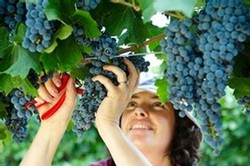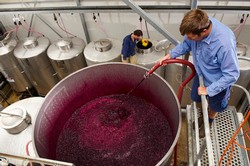How is red wine different to white wine?
I'm thrilled to offer you an exclusive insight into the intricate process of crafting our red wines.
At Upper Reach, we believe that wine is not merely a beverage but a culmination of artistry and tradition, spanning over 8000 years of history.
Step 1: Cultivating Excellence in the Vineyard
The journey begins in our meticulously tended vineyards, where Derek, as viticulturist, passionately nurtures the finest grape varietals. With unwavering dedication, we handpick each grape, ensuring only the best fruit is selected for the winemaking process.
Step 2: The Art of Juice Extraction
Once harvested, the grapes undergo a delicate transformation.
The fruit is left in the coolroom overnight, so that it is at 4 degrees.
The next morning we gently crush and destem them, meticulously extracting the flavors and aromas.
The machine, a crusher, rotates and gently squeezes, breaking the skins so the stems are spat out the end.
The resulting slurry known as "must", is a blend of skins, pips, flesh, and juice.
 Step 3: Fermentation -when the magic happens
Step 3: Fermentation -when the magic happens
Yeast meets grape sugars, giving rise to a heady mix of alcohol and carbon dioxide.
Our slow controlled fermentations take about two weeks. We manage the ferment so that each day the juice reduces it's sugar level by one baume and increases the alcohol level by one degree of alcohol.
As the days pass, the grape skins dance upon the surface, infusing the wine with depth and character.
Step 4: Elevating Complexity through Pump Overs
To unlock the full spectrum of flavors, our winemakers undertake meticulous pump overs (every 3 hours), pumping and stirring the wine and grape skins together; tannins emerge, giving structure and color upon the evolving liquid masterpiece.
Step 5: The Pressing Process Unveiled
As fermentation draws to a close, our attention turns to the press— ingenuity and efficiency.
Wine Press: about 85% will cbe drained out of the fermente as 'fre-run juice', it will easily run or even pour out of the tank, but the remaining 15%, mainly skins,pips and grape flesh will typically be shovelled into the wine press.
Check out Lauren's ingenious method as we gracefully extract the essence of the grape, leaving the purest expression of our craft.
Step 6: Aging in Oak Barrels
All our red wines are aged in oak barrels, where time becomes our ally. Here, the wine matures and evolves, dveloping complexity and refinement.
Join us on this immersive journey into the heart of winemaking—an odyssey marked by passion, precision, and unparalleled dedication.
As esteemed members of our community, your support fuels our commitment to excellence.
Thank you for your unwavering loyalty and appreciation for the finer things in life.
Step by step guide to how to make Red Wine.
Red wine making hasn't changed as much as you'd expect over the last 8000 years....
- First grow your grapes, Derek strongly believes that wine is made in the vineyard. Wine is effectively fermented grape juice- so the best tasting, most flavourful grapes will make the best juice, which will make the best wine.
- Pick the grapes, we hand pick everything. This means we don't pick any damaged or imperfect grapes- so quality control begins with grape picking.
- Juice the grapes: Crush & destem them. We'll have left the fruit in the coolroom overnight, so that it is at 4 degrees. Then we'll pour whole bunches of grapes, and yes they look exactly like grapes you'd buy at the market, into the top of the crusher de-stemmer.
The machine rotates and gently squeezes, breaking the skins so the stems are spat out the end. - The resulting 'slurry' is called must; its a mixture of skins, pips, flesh and juice of grapes. It looks a bit like what comes out of a Nutri-Bullet!
- Must is then pumped into a red fermenter; at Upper Reach these are all open fermenters, allowing lots of air to be in contact with the must.
- Alcoholic Fermentation: add the yeast, it reacts with the natural fruit sugars to form alcohol and Carbon Dioxide.
- Over a day or two the grape skins float up and form a layer on top of the wine, a 'cap'.
During the red wine fermentation we aim to leach out the red colour and flavours from the red grape skins. So the wine needs to be mixed or 'pumped over', to pull out the tannins, giving the wine structure and colour. - Pump Overs: the wine is pumped from the bottom of the tank and sprayed over the 'cap' of grape skins that float on top of the wine, for about 30 minuites every three hours.
- Fermentation: after about two weeks of slow controlled fermentation, where each day the juice decreases one degree of sugar and increases one degree of alcohol, the wine goes into the Press.
- Wine Press: about 85% will cbe drained out of the fermente as 'fre-run juice', it will easily run or even pour out of the tank, but the remaining 15%, mainly skins,pips and grape flesh will typically be shovelled into the wine press.
- Check out Lauren's brainwave. At Upper Reach we'd rather work smarter not harder... have a look at how we get the red wine skins out of the fermenter into the wine press.
Be warned: it's a messy business!
Most Red wines will then go into oak barrels for ageing...